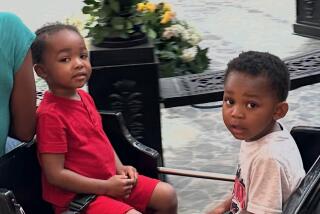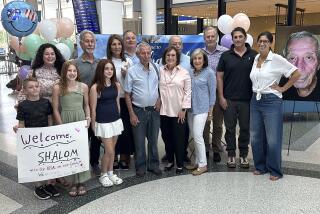Her Work Has Her Seeing Double
- Share via
Tammie and Tapatha Rodgers sometimes have the exact same dream. They’re college classmates, roommates. They share nearly everything; Tapatha says they even take turns being dominant.
They’re identical twins, each with 100% of the other’s genes.
“We’re as close as two people can get,” says Tapatha, 21, of Fullerton.
The psychology of the Rodgerses and thousands of other twins is the life’s work and fascination of Nancy L. Segal, a nationally known twins expert who teaches at Cal State Fullerton.
Public interest in twins has never been higher, says Segal, 46. In the last year, she has been swamped with requests for speeches, magazine articles, TV documentary consulting work, expert-witness appearances and research. The recent brouhaha over cloning only added to her scientific celebrity.
Interest in twins is such that Segal, a behavioral geneticist and professor of developmental psychology, has been asked to write a book. “Friendship Extraordinaire: Twins and What They Tell Us About Human Development and Personality” is scheduled to be published next year by Dutton Press.
In the five-year history of Segal’s Twins Study Center at Cal State Fullerton, more than 100 pairs of twins have participated in research ranging from olfactory perception to bereavement levels.
Segal’s overriding goal: to help solve the nature-versus-nurture riddle--that is, to determine which of our behaviors is influenced by our genes and which by our home environment.
Twins are the ideal subjects--”a natural living laboratory,” Segal says. By studying them, Segal sees potential solutions to behavioral questions that can’t otherwise be answered, even by human clones, since clones would not have shared the womb and early upbringing.
Twins separated at birth can show eerily similar behavior. Segal participated in a follow-up study of one such identical pair--Jim Lewis and Jim Springer.
The Jim twins, adopted by separate Ohio families a few weeks after birth, were reunited 39 years later, in 1979. What they discovered about each other’s history, beyond being given identical first names by their adoptive families, reveals the powerful grip of their shared genes:
Both had been part-time sheriff’s deputies and had worked at McDonald’s and gas stations. Each enjoyed carpentry as a hobby. Each used the same slang. Each chain-smoked Salems and drank Budweisers (and crushed the empty cans). Both married women named Linda and later married women named Betty. Each drove the same model blue Chevy to vacation at the same three-block stretch of beach in Florida.
Identical twins’ similarities can sometimes be hard for others to accept. A few years ago, Segal says, a pair of twins missed the same answers on a college test and were accused of cheating. Segal was asked to verify that it was indeed plausible that the two might score the same. She did, and the cheating charges were dropped.
*
Segal has studied the bond between identical twins and has found the level of grief a twin experiences when the other twin dies is greater than that experienced after the death of a mother, father or other sibling and equals the bereavement felt when a spouse dies.
Such data have proved attractive to lawyers trying to maximize damage awards in wrongful death cases, and Segal has appeared as an expert witness in such trials about a dozen times.
Central to Segal’s research is documenting how twins interact with each other.
“Her specialty, perhaps the only person in the world to do it, is to use twins to study the genetics of cooperation and competition,” says Thomas Bouchard, director of one of the nation’s oldest twin research centers, at the University of Minnesota. “She uses twins in a broader way than any other investigator I know.”
Growing up in New York, Segal says, she was always interested in why she and her fraternal twin, Anne, weren’t very much alike.
“Then when I got to college and became interested in psychology, this whole area was fascinating to me because it provided answers to questions I’d had growing up. Why is it that two related people can be so different?”
She began finding answers at the University of Minnesota, where she was assistant director of the Minnesota Center for Twin and Adoption Research.
*
Twin research is not without its critics. They say it’s hard to pinpoint how much of twins’ behavior is due to genes and how much is a result of their having had common treatment.
As a partial response, Segal is completing research she says is “precisely the reverse” of studying identical twins who were raised apart, such as the Jim twins.
Her study, to be published in June in the Journal of Educational Psychology, looks at unrelated siblings of the same age who are reared together.
“My argument is, let’s look at kids who are reared together but who have no genes in common, such as a boy and his adopted brother of the same age. So far, the data suggests they’re not very much alike at all.”






